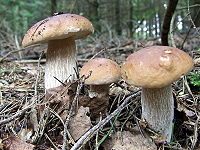Boletus
| Boletus | |
|---|---|

| |
| Boletus edulis | |
| Scientific classification | |
| Kingdom: | |
| Division: | |
| Class: | |
| Order: | |
| Family: | |
| Genus: | Boletus |
| Type species | |
| Boletus edulis Bull. (1782)
| |
| Diversity | |
| over 100 species | |
Boletus is a genus of mushroom, comprising over 100 species. The genus Boletus was originally broadly defined and described by Elias Magnus Fries in 1821, essentially containing all fungi with pores. Since then, other genera have been defined gradually, such as Tylopilus by Petter Adolf Karsten in 1881, and old names such as Leccinum have been resurrected or redefined.
Some mushrooms listed in older books as members of the genus have now been placed in separate genera. These include such as Boletus scaber, now Leccinum scabrum, Tylopilus felleus, Chalciporus piperatus and Suillus luteus.
The name is derived from the Latin term bōlētus 'mushroom' from the Ancient Greek βωλιτης,[1] ultimately from bōlos/βωλος 'lump' or 'clod'.[2] However, the βωλιτης of Galen is thought to have been the much prized Amanita caesarea.[3] In Lithuania Boletus is called "The King Of Mushrooms".
Edibility

The genus Boletus contains many members which are edible and tasty, not the least of which is the famed Boletus edulis, though many others are eaten as well, such as B. badius, B. aereus and others. Many species, such as B. calopus, are bitter tasting and inedible, and others are toxic.
Several guidebooks recommend avoiding all red-pored boletes; however, both B. erythropus and B. luridus are edible when well-cooked. One instance of death from Boletus pulcherrimus, though, was recorded in 1994; a couple developed gastrointestinal symptoms after eating this fungus, with the husband succumbing. The autopsy revealed an infarction of the midgut.[4] Boletus satanas has also long been considered to be poisonous, though it has not been responsible for any deaths. The symptoms are predominantly gastrointestinal in nature. A glycoprotein, bolesatine, has been isolated. A similar compound, bolevenine, has been isolated from the poisonous Boletus venenatus of Japan.[5]
Muscarine has been isolated from some red-pored species, although the amounts are pharmacologically insignificant and unlikely to cause symptoms.[4]
See also
References
- ^ Simpson, D.P. (1979). Cassell's Latin Dictionary (5 ed.). London: Cassell Ltd. p. 883. ISBN 0-304-52257-0.
- ^ Liddell, Henry George and Robert Scott (1980). A Greek-English Lexicon (Abridged Edition). United Kingdom: Oxford University Press. ISBN 0-19-910207-4.
- ^ Ramsbottom J (1953). Mushrooms & Toadstools. Collins. p. 6. ISBN 1870630092.
- ^ a b Benjamin DR. "Red-pored boletes": 359–360.
{{cite journal}}: Cite journal requires|journal=(help) in: Mushrooms: poisons and panaceas — a handbook for naturalists, mycologists and physicians. New York: WH Freeman and Company. 1995. - ^ Bolevenine, a toxic protein from the Japanese toadstool Boletus venenatus Matsuura et al Phytochemistry Volume 68, Issue 6, March 2007, Pages 893-898
External links
![]() Media related to Boletus at Wikimedia Commons
Media related to Boletus at Wikimedia Commons
- YouTube Video:Boletus species and more.. by Bill Yule, Connecticut Valley Mycological Society
